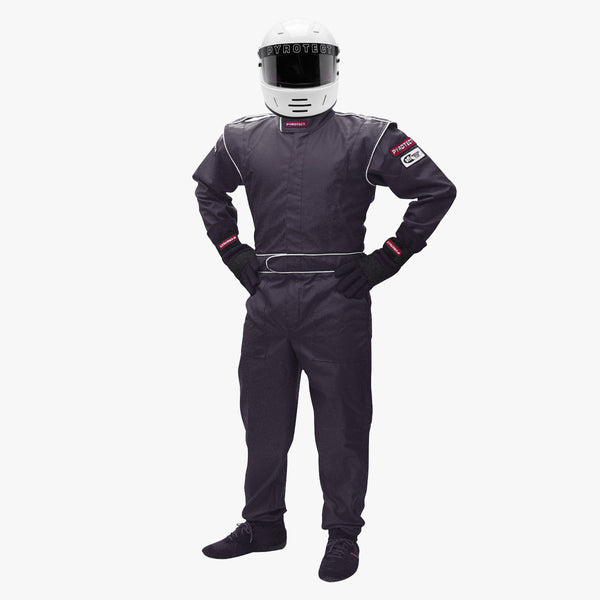Pyrotect Junior Deluxe One Piece 1 Layer SFI-1 Suit
Shipping calculated at checkout
Lightweight, Stylish, Comfortable and loaded with features, the PYROTECT Sports Deluxe, Single Layer, SFI 3.2A/1, One Piece Drivers Suit is manufactured using an FR material with Knit Lined Collar.
- 360° Vented Arm Attachment
- Epaulets
- Vented Waist Expansion Panel
- Hidden Slash Pockets
- Hidden Boot Cuffs
Understanding Fire Suit Ratings
The following is from the SFI Foundation. Please check with your sanctioning body to ensure compliance before buying any piece of safety equipment.
The driver suit spec 3.2A tests a garment’s fire retardant capabilities. The spec contains a rating system based on the garment’s capability to provide Thermal Protective Performance (TPP) in the presence of both direct flame and radiant heat. The purpose of the TPP is to measure the length of time the person wearing the garment can be exposed to a heat source before incurring a second degree, or skin blistering, burn.
The TPP rating is the product of exposure heat flux and exposure time. The TPP results can be converted to the time before a second degree burn occurs. The higher the garment rating, the more time before a second degree burn. Here are the SFI ratings with the corresponding TPP values and times to a second degree burn:
| SFI Rating | TPP Value | Time to 2nd Degree Burn |
|---|---|---|
| 3.2A/1 | 6 | 3 Seconds |
| 3.2A/3 | 14 | 7 Seconds |
| 3.2A/5 | 19 | 10 Seconds |
| 3.2A/10 | 38 | 19 Seconds |
| 3.2A/15 | 60 | 30 Seconds |
| 3.2A/20 | 80 | 40 Seconds |
Another test included in the spec is the after-flame test. When a direct flame is applied the fabric and them removed, the time it takes the material to self-extinguish is measured. This is called after-flame time and it must be 2.0 seconds or less for the layer of fabric to pass. Cuff material is also subjected to this test.
The flammability test evaluates single layers of fabric only. The individual layers of a multiple-layer suit are tested for after-flame time separately.
The TPP test can be used to evaluate multiple-layer configurations as well as single-layer fabrics. The samples used in testing are assembled with the identical fabrics and layer order as an actual driver suit.
Other tests required by Spec 3.2A include thread heat resistance, zipper heat resistance, and multiple layer thermal shrinkage resistance.



